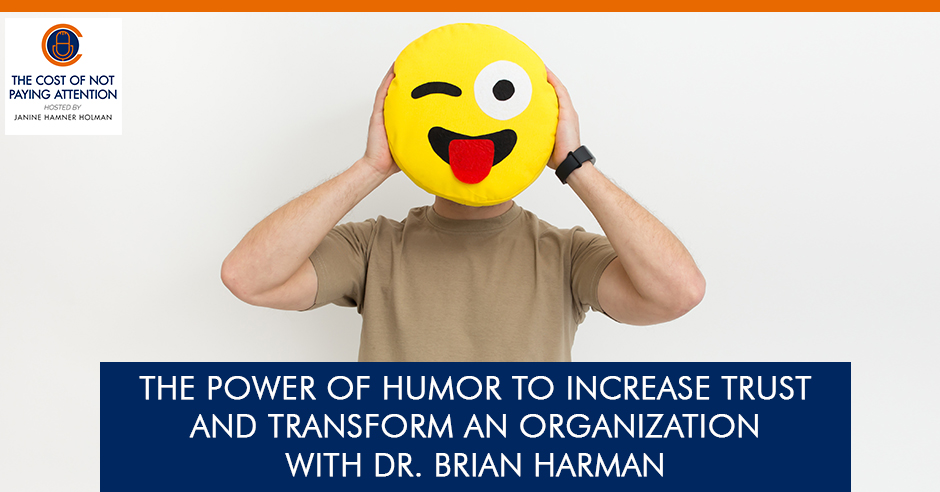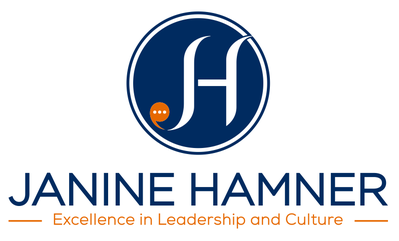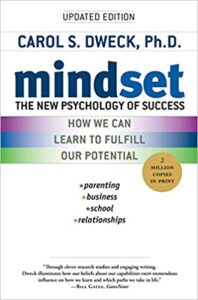
Research studies have revealed that humor is linked with social relationships and can effectively reduce stress and enhance empathy – two of the key metrics for emotional intelligence and psychological safety. Janine Hamner Holman sits with the passionate and energetic executive coach, Dr. Brian Harman, to talk about the connection of humor to trust and how it can serve to transform an organization. He then expands on the idea of how laughter makes a safe environment, which then leads to empathy, and gives some tips on how to listen and communicate effectively to gain trust. Get some insights on the effect of sharing personal stories and experiences in building rapport and bringing in humor to your organization through this conversation.
HOST: Janine Hamner Holman | [email protected] | LinkedIn, Facebook, and Twitter | Subscribe to my Newsletter! Book me to Speak!
—
Listen to the podcast here:
The Power Of Humor To Increase Trust And Transform An Organization
A Conversation With Dr. Brian Harman
What am I paying attention to now? The power of empathy. We’ve been hearing so much lately about empathy. Empathy is one of those things that if you are naturally empathetic, you’ve studied emotional intelligence, or you’ve gotten an introduction to empathy, you understand its power. A lot of what we’re hearing now is, “Be empathetic.” But, if you don’t know what empathy is, it’s hard to be empathetic! Empathy is about getting into somebody else’s emotional shoes, and then even going the next step and feeling their feelings with them, which brings me right into our guest.
Dr. Brian Harman is such a wonderful guy. He is a passionate and energetic executive coach who is focused on helping his clients achieve extreme levels of trust in their leadership teams. We’re going to dive into that part in particular, but we will talk about some of these other things as well. He is a three-time TEDx speaker and leadership professor from Los Angeles who is married to his first childhood love! After surviving a rare bone disease and enduring four spine surgeries, he ditched his corporate job so he could go help leaders bring more love and trust into the workplace. He’s also obsessed with LinkedIn and posts daily videos there.
—
Welcome, Brian.
Janine, thank you so much. My oldest brother is Jonathan Harman so it’s a JH like you. Thanks for having me. I’m happy to be here.
I’m glad to have you. Brian and I got to know each other since one of the things that I love is getting connected to people who are also in the consulting space. There’s a number of us and everybody has their individual flavor. I love Brian’s flavor. Brian’s flavor is all about trust, and it’s also all about humor. One of the things that’s not in his bio is that he has a PhD in Humor, connecting humor to trust, and how humor can deepen and compel trust forward. I may not have said that perfectly, but Brian is going to clear it all up.
Brian, tell us more about that. Tell us what’s the thing that you think would be great if people paid more attention to now. What’s the cost of not paying attention to that thing?
We laugh with people that we trust. Share on XThank you for the great introduction. It’s cool what you do to focus on empathy. Having a conversation about trust and empathy is something that in my book never gets old. This is a fun conversation. The reason that I wanted to study humor was because, in my professional life, I didn’t see a lot of it. When I did see it, I didn’t feel included in it. I worked in construction management for fifteen years. We all know that construction is hard nosed and very aggressive, but it also can be a humorous type of environment. There’s a lot of initiation, hazing, mobbing, and that blue-collar service mentality. I’m no stranger to that. I started at “the end of a firehose” in the landscape. I installed bathroom stalls for over a year and for a couple of summers with my oldest brother, Jonathan.
I was working in that environment, then spending fifteen years there, and then going into biotech where it’s all sensitive and people cared. There are no deadlines. It’s like, “Let’s do this as a team.” So I’ve seen the two extremes in the workplace. Over all of this, one of the things that I found that’s unique and got me an interest to study more about was the idea that trust is a prerequisite for humor. Even at a biological level, one thing that people have seen is that we laugh with people that we trust. I didn’t come up with this. This is from past research.
One of the reasons for humor being a trust-building behavior is a biological reason. When you lift up your neck and you laugh, you expose all those vulnerable body parts like the jugular vein, carotid arteries, and cranial vagus nerves. The parts that are signaling to another person that, “I can be open with you.” It’s intimate. If you think about with a romantic partner, you only do those vulnerable physical types of behaviors with people that you feel you can let your guard down with. Humor is interesting. There are many pieces like that.
It’s another reason why women are better at evaluating humor than men. It’s because humor is a social intelligence tool. Women are biologically and evolutionary better able to see in others what are their most intelligent factors. Humor is one of those. People that are funny, witty, and quick with a joke, have certain skills that are good for certain social engagements and interactions. It’s all of that stuff to say that trust is the foundation. I’ve learned that that’s the most important thing. When you get into a workplace where you see people laughing and you can always hear people with that lightness, that mood, it shows you’re in a high trust environment. That is the indicator to me that that’s a company that I want to spend more time in.
I love that distinction. That’s interesting because I had never connected that. I’m a person who loves to laugh. I have a big laugh and I often will throw my head back. Sometimes, I will throw my head forward. I’m now thinking, is there a connection between the times when I throw my head forward or the times when I throw my head back having to do with trust, and what my connection is to the person who’s made something funny, done something funny, or said something funny that I’m reacting to? I never made the connection to high trust organizations being a place where humor and lightness is something that can be cultivated.
I want to give you a little plug. Brian works with organizations that have been around for years, are fairly well-established, and interested in creating that high trust executive team. What else have I missed in terms of the perfect kind of organizations that you love working with?
One of the key pieces or the requirements that I require before I engage with a client is they have to have a purpose that’s driven by empathy. If they’re aggressive, mal-intentioned, very self-serving, and their only purpose is to exit and make money, I don’t have much interest in working with that leader. It doesn’t fuel me, jazz me up, or get me excited about working with someone. I want to be with the leader that maybe are not doing everything right, but at least their purpose or intention is, “I want to build a more empathetic workplace.” That’s not easy.

Humor And Trust: We laugh with people that we trust. Humor is a trust-building behavior for biological reasons.
People say, “I was just listening.” It’s not just listening. Listening is a hard thing to do. We don’t give people enough credit. The good listeners out there are rare individuals. One of the things that I like to tell my clients is that, “You need to let people know that you’re listening. Not just active listening and the normal stuff but repeat, clarify, and ask them, “Is my understanding right?” If they say, “That’s right,” that’s an indicator back to you saying, “I get them and they get me.”
That is what empathy is.
This whole golden rule, “Treat people how you want to be treated,” I hate that. It’s extremely arrogant. I want to treat Janine the way Janine wants to be treated. I want to treat Joe the way Joe wants to be treated, not the way I want to be treated because Brian has different wants and needs. We’re different people. In order to get into that level of depth and empathy, you must be present and such a good listener. I’ve only seen it a few times in my whole career so far.
It’s a special kind of leader. One of the things that I’ve been working with a couple of clients on is growth mindset and fixed mindset. The places where we’re in a fixed mindset, and to give a quick 10,000-foot description, a fixed mindset is: “I am good at math. I am super smart and better than you… if I tell the truth.” When you get into a fixed mindset, it’s a lot of my self-identification is connected to, “I am smart. I am good at math. I am intuitive. I am good at chemistry,” which I’m not. I’m not good at math or chemistry.
If that’s how I self-identify, then anything that threatens me being good at math, chemistry, or smart, I can’t tolerate because it is a direct affront to who I hold myself to be.
Versus in a growth mindset, I might feel smart. I might feel like I’m not good at math, which is the way that I hold myself. I’m not really good at math. I’m a good scuba diver. To get to be a good scuba diver, you have to understand math, physics, and all kinds of things that are not my strong suit, but I love scuba diving. I got good at those pieces of that thing to enable me to enjoy this thing that I love. That’s the growth mindset.
I’m re-reading a book by Carol Dweck who is the pioneer of growth mindset and fixed mindset. She’s the first person to uncover these distinctions. She’s talking about various leaders and sports figures who we’ve all heard of and where they are in terms of growth mindset and fixed mindset. Lee Iacocca is one of the people that she loves to point to in the fixed mindset.
What Lee Iacocca cared about was Lee Iacocca. When he got expelled from Ford, that was such a crushing blow to his ego that then who he became was somebody to prove to Ford that he was better than them. That was his whole mission at Chrysler. He brought Chrysler up to this huge pinnacle, but then became about promoting Lee Iacocca. Chrysler then started declining, and he couldn’t get out of his own way to help Chrysler be what Chrysler needed to be because he was about who Lee Iacocca was.
We all sway in that just like we are not one thing. We are also not either always in a growth mindset or always in a fixed mindset – sometimes we are in one and sometimes where in another. It’s much more challenging when we are in a fixed mindset, but even those of us who understand this, we’re not always in a growth mindset! We fall back into fixed mindset because we’re humans.
When you’re working with organizations and you’ve got somebody who’s interested in creating that high trust, creating that empathetic experience for us people and her people, learning how to listen: I call these organizations with high emotional intelligence and psychological safety.
Tell me about how you bring in humor because I find that really interesting. How do you bring that in and have that be part of what people begin to experience in a different way?
The growth mindset and the fixed mindset is coincidentally related to this. Think about the undertones of why you and I are talking right now. We’re both in the same field seemingly competitors, yet why would we be collaborating? This is very much about relational trust with you and me. We’re telling each other our stories and sharing our experiences. We’re building up that base of the pyramid. It’s a very much growth mindset because, if you are going to go and collaborate with your competitors, then you’d have to be in a growth mindset.
The purpose of humor is really just to make people smile. Share on XWhereas someone that’s fixed would be like, “I don’t want to share my secrets. I don’t want to be around people like me.” I’ve found exactly the opposite happens is, once you break down that weird concept, competition doesn’t exist. When you get out of that, when you shake free of that box or boundary, then you find what we’re doing. Having an open conversation about stuff. I don’t know where this conversation is going to take us, and I’m already learning cool things. I’ve never studied growth mindset. I don’t know a lot about it, but I noticed that there are a couple of key philosophies that you spoke about that I resonate with.
Number one is don’t see people as competition, see them as accommodators, collaborators, challengers, people who can push you into anything that can provoke new thought. Who are better to do that than people that are in a similar field? If I talk to a CEO of a software company, we’re going to have less of that push and challenge to each other than you and me who both work in leadership development. In truth, I’m far less experienced than you. I’m coming into this like, “Open your ears. How can I listen and take things away?” On the humor side of things, build that base of trust, share the stories, get on the same page, get the friendship, the rapport, the positive emotions that are going back and forth. You can hear smiles. It doesn’t have to be laughter and audible. You can hear when there’s a good vibe. It feels like there’s an emotion, there’s a vibe. Once there’s that, I’m more apt to use humor. I’m more in the place of being ready like, “Now, I can start to look for a couple of funny things that might be a joke worthy or story-worthy as a secondary.”
Humor is the X Games of workplace communication. Share on XThe first thing I want to take humor off the table. The purpose of humor is to make people smile. It doesn’t have to be a joke or some entertainer audience like I’m performing right now. It has to be about a smile. That’s more than enough. If you’re making someone smile, you’ve already done the hard work. Humor is the X Games of workplace communication like negotiation and conflict resolution. You never have to deal with any of that stuff if you can’t get through the base of trust. That’s the building block 101.
One of the things that I’ve been interested in is we are living through some unprecedented times. They’re unprecedented on a number of levels. We’re all at various levels depending upon where we live in the country and the world dealing with COVID-19. We are all dealing with the uncertainty that comes with that. As you and my audience know because I talk about it all the time, just like Brian is obsessed with LinkedIn and many other things, I’m obsessed with brain science and why our brain does what it does.
One of the things that our brain is obsessed with is our safety. I’m glad that there’s a part of my body that’s obsessed with my safety. But, it’d be helpful if there was a dial where we could dial it back because our brain equates safety to certainty. It’s the reason that we’ll pick fights with people to get to certainty. Our brain hates uncertainty and we are swimming in a world of uncertainty.
Here in the US, especially in California, we’re also dealing with all of this uncertainty around our economy. I was talking to somebody whose young son was going to school for the first time and he’s five. My buddy has all these complicated feelings about his son going to school. There’s that, “My baby is going to school,” but then there’s also, “My baby is going to school in the middle of a pandemic. Is he going to be safe? Am I doing the right thing?” His son is so excited about getting to go to school and getting to be with other kids. We grownups are missing being with other people a lot. Our little people are missing it at a level that is hard for us to comprehend because their socialization brains are still so much in formation. They’re missing that connection.
We’ve got all of this uncertainty about the economy and businesses trying to figure out the whole work from home, hybrid, hoteling etc. formula that works best for them. We’ve got all of this uncertainty in national and international conversations around race, equity, justice that is generations overdue. In this country, it feels like we are still living through an election. It feels like the most polarized this nation has ever been.
I’ve been working with a couple of different organizations about that issue around diversity, equity and inclusion. One of the things that I talk about is this component of trust. In my experience, in my opinion, diversity is essentially an HR issue. You can hire for diversity. You get people who are different from whatever the norm is, and then you’ve got diversity. The challenge is if you don’t have a high trust organization or psychological safety inside that organization where it’s cool for me to be whatever it is that’s not the norm, whether that’s black, brown, Asian, rich, poor, working class, straight, gay, transgender, or whatever the factors of diversity are, then I’m going to leave or I’m going to suppress it.
If I’m black (and my husband who’s walking around as we talk happens to be black), there’s not much you can do to suppress your blackness. The reason that the best organizations are looking for diversity is because we make so much better decisions when we have a diverse organization. We are so much more agile, make better decisions, and are more resilient through diversity. It’s not just that we want to do the right thing, look right or politically correct. There are real strong business reasons to be diverse. I see such a connection between high trust organizations that you’re all about creating and diversity, equity and inclusion. Is that something that you bring in to the organizations that you work with?
It has been. It’s because I see a lot of those as synonyms. Equality, inclusion, sense of belonging, and diversity: they’re all trust. If you look at the organizations that are thriving right now, they’re the ones that are resilient and adaptive to change. That’s because they have leaders who build trust, who have psychological safety, and their employees generously contribute creativity and good ideas. If the leader is one who’s been getting off the hook far too easily and has been letting this environment fester pre-pandemic where people just clock-in, do their work and bounce, they’re not doing well right now. Trust adds up and the economics are clear. If you’ve built that over time, then it costs you less and you can get stuff done faster. It’s not just change and resilience, but you can act and take quick action.
When unprecedented external factors like a pandemic hit us, what are you going to do? Can you adapt? Can you move? Can you shake? Can you get things put into motion? Some companies are still barely going remote. We’ve been here for months. What are you doing messing around with remote at this point? That should have taken you four days back in March 2020. If leaders were not focused on trust, not making a real deliberate trust plan, not using their core values to drive their decisions, not purpose centered in getting trust as a differentiating factor within their workplace and culture strategy, then shame on them. They don’t deserve to be thriving right now. A lot of them aren’t and they’re not surviving.
If we have audience out there who are organizational leaders, either they’re leaders in terms of their position in the organization or in terms of their impact in an organization, and they’re thinking, “I don’t think we have a high trust organization but this sounds it’d be a good thing for us to start working on.” In addition to hiring you, what would be a way that they could get started? What would be the first baby steps that would be great for an organization or an organizational leader to start taking?
Trust is a shocking statistic but I’m not surprised. There was a study that shows almost 60% of people trust strangers more than their boss. The reason for that is because every daily interaction within the workplace can do three things. It can be trust improving, trust neutral, and trust degrading. Corporate America has shown us time and time again that the manager-subordinate relationship is not healthy. There’s Gallup, analytics, statistics, all that stuff. It’s out there and it’s real.
It’s not just some companies. 85% of people are mentally checked out from their jobs. This is a systemic chronic issue. Trust on an institutional level has been taking a dump since the ‘50s.
Who’s responsible?
Leaders are responsible.
You could hire me or you but you don’t even have to do that. Pick up a book. There’s some good information out there that’s been disseminated that allows you to take action. Stephen MR Covey wrote The Speed Of Trust. That’s a good book. It got me amped about trust. I dedicated my whole PhD to it. That’s a small baby step that someone could take in a day that would make a massive difference in what they do, how they see trust, and understanding the benefits and importance of it as a differentiating strategic factor as a leader.
Some of the other things you can do outside of that is take notice of self-reflection. There’s a way to shake someone’s hand and build trust, and there’s a shitty way to shake a hand. Is your heart facing their heart? Are your shoulders parallel? Do you smile when you look into their eyes? Do you understand the color of their eyes? Was there no eye contact? Do you do that weird side shake?
When we have a diverse organization, we are more agile, make better decisions, and are resilient. Share on XDid you give them a limp dead fish? That is my pet peeve. “I don’t want to shake that.”
I use the “match pressure plus 5%.” It’s my rule. This will sound creepy but it feels good. The thing that’s released during sex, childbirth, hugs, high-fives, even any skin-to-skin contact is the oxytocin molecule. When I shake hands, I like to go a little bit deeper into the bloodline here. You can give that person a little boost of oxytocin. Don’t pat them on the shoulder, don’t double pat their hand, don’t exert extra control, just give them a nice little bit extra pressure. Not 20% but 5% extra pressure, enough eye contact to get the color of their eyes, and then give them a smile.
That’s a simple handshake but it goes all the way into how you send your emails, how you fill up the relationship bucket with positivity so that when you need to give constructive feedback, you’re not going from a place of that’s all you give them. Read some books, take some self-reflection, and understand your activities.
We’ve all had bad managers but sometimes, we are the bad managers. We think we’re not the problem, but statistics tell us otherwise.
I love that reality. I led a webinar on listening a while back. We were talking about listening and how much of a skill listening is. There is something called the International Journal of Listening. According to them, on average, people spend 2% of their time at work listening which I found startling. There are some professions in which you don’t have to listen at all: if you’re a poll taker or you’re something where you have essentially no contact with people. There are other professions in which you have enormous contact with people, and still, on average 2%.
Ninety-one percent of employees think that their manager doesn’t listen. We know that 90% of managers have never been trained to be a good manager.
One of the things that I said in that webinar is if 91% of employees think that their manager doesn’t listen, it’s likely that includes you even if you think you’re a good listener.
I love the tips and ideas that you gave about how to communicate that you’re being present, you’re listening, you’re connected to them, and you’re checking in with, “Did I get it right?”
Improv humor is a good one. That’s the greatest way to learn how to listen.
Tell me more about that.

Humor And Trust: The organizations that are thriving right now are the ones that are resilient and adaptive to change.
I did an independent survey study in 2020 with 100 people in it. I asked leaders, “What was the most crucial skill of a leader?” They said listening. On the second part of the survey, I was asking them, “What are their most trained skills?” Listening ranked the last.
A lot of people are attending classes and courses on listening. It’s so cool that you did a whole webinar dedicated to it. It’s an important, underrated, underserved topic. To me, improv is one of the great ways to practice it. The improv teachers that I’ve had changed my life when it came to listening because all you do in improvisational humor is listen and then act. The ones that are good or the funny people, they have a weird sense of presence. They’re way more engaged than the rest of the population. I would highly encourage people to jump in. There’s a bunch of open enrollment type improv humor classes out there that the different improv theaters put on. I’ve taken fifteen of them at this point. There is no lack of fun, humor, and listening involved in those sessions. I highly recommend it.
I love that suggestion. That’s awesome. We’re in this time where we’re all distant. That sounds something that could be super fun. Even if you’re doing it over Zoom, it could be connecting and helping to train up that skill. In this time, when many people are supervising others, trying to manage themselves, and manage other people over Zoom, organizational culture is becoming much more diffused because we’re not connected in the same way of presence where we were.
If you had some suggestions for what people could do in this time when we’re so disconnected from each other, to help keep that trust alive, do you have thoughts about tips and tricks that managers and employees could use?
The easiest thing and the thing that I asked my clients to do is take the explicit time to schedule personal stories. I use Gustav Freytag’s framework. A couple of hundred years ago, he made an adaptation from Aristotle’s three-act play and it goes context, problem, climax, resolution, call to action or denouement. The way that I like to encourage my clients to use this framework is by setting up time for one-on-ones with all your direct reports and sharing your personal story. The personal story would go from birth into what got you into the room now. What are the big turning points that you’ve overcome? What are the happiest personal and professional moments that you’ve had? What are your big achievements? What is your purpose?
That’s a simple meeting. It’s 30 to 60 minutes and it’ll be something that seems cheesy like, “Let’s share personal stories,” but every time you get off that phone or zoom or meeting, you’ll be glad that you did that. It’s the most high value and high impact way that you can connect with someone on a relational trust level. Whether or not you and I share an exact personal story, there will be little snippets and pieces that you and I had no idea we could have ever possibly related on. I dropped out of college to take care of my aunt who had a brain aneurysm. Even if you never dealt with that, maybe you’ve taken care of a family member who was ill. It might be my spine surgeries or maybe you’ve dealt with a personal injury. Who knows? There’s only one way to find out if we have that connection. That is if we explicitly take the time to share those personal stories. Because we’re on Zoom and we’re not doing as much bumping into each other or going out to the lunch, cafeteria, or restaurant down the street, we’re not getting that time right now.
We need to say, “I’m going to block this chunk of my day to go and have personal storytime with the people that I care about.” Our colleagues, this is our community. This is where we live. This is where we spend all of this time. Shame on people who don’t know the personal life story for the people that they work with. These are our friends. When you build that level of admiration with your fellow colleagues, you don’t let each other down. That’s an extreme form of trust once you’ve done that.
I will also say that it’s the responsibility of the leader to open up further and to open up first.
If you think of trust as a reciprocal emotion where I smile, you smile, happiness is reciprocal, we feel it. If it’s around us, we feel it too. The same thing goes for trust. If you’re going to open up and you’re going to tell me some deep, profound things about your life, if you’re going to share those personal moments with me that you don’t usually share with colleagues, I’m going to be a lot more apt to share that stuff with you. I have to go a few levels deeper than the surface. I have to give you the “why” so that you’ll at least give me the “why.” Otherwise, we’ll sit up in surface land, we’ll never make real connections, and we’re all in a shitty world.
Don't see people as competition. See them as those who can push you into anything that can provoke new thoughts and make you better. Share on XA shitty world is not where we want to be. I love the power of storytelling. I’ve gotten to know Brian in this COVID time. It’s very strange. When I read that about your spine surgery, I had an awe. We have this close family friend in my family of origin, Peggy, who went through horrible cancer and had spine surgery. I went through that with her. It immediately connected me to that in my past. A feeling of empathy. I’ve had knee surgery twice. Knee surgery sucks but spine surgery is at a whole other level of suckage. There was like, “Brian, poor spine surgeries.” It connected me with Peggy who passed away a number of years ago from that cancer. It connected me back to her who I love. It then created this love transference. I got connected to Peggy which also connected me to you.
For leaders who feel like this all sounds touchy-feely and weird, one of the things that I would love if we could find a new word for is vulnerability because that’s part of what you’re talking about. It’s the opportunity and the need to be vulnerable first. We all know it sucks to say “I love you” first. Those moments of getting out there, putting ourselves out there, putting our heart, or our emotions on the line, making our soft tender spots vulnerable to other people is scary. In our Western culture, we have equated vulnerability with all kinds of pejorative things. It means that you’re soft, wimp, pussy, all kinds of derogatory things.
How do you help somebody who does not have a muscle built in for being vulnerable, and in being vulnerable with people who report to them? How can they lean into that feeling of uncomfortableness? As we know, the first time you try something, you’re not so good at it and it feels uncomfortable. How can we get started in that to help model that for the people that we want to be connected to? We’re talking about business, but this is true in romantic relationships, friends, children, siblings, and all of those relationships where trust and vulnerability are so important.
Practice can make perfect. If they want to try to be open, the greatest place to always start something that is either with a coach or a mentor. If they open that up a little bit further, and then practice with a friend or a colleague, they can start to see like, “There is a lot of value in that. My openness can help me.” For example, I teach as a leadership professor but I wear a hat and a hoodie in class because I don’t want there to be a power distance and this hierarchy differential that creates the vibe that’s not necessary. I practice openness. I purposefully polarize my potential prospect clients.
What does that mean that you intentionally polarize your prospect clients?
Even though I have a PhD and it seems he’s got his shit together, I didn’t have my shit together for a long time. I had issues with alcohol, drugs, depression and anxiety, that whole four spine surgery thing physically sucked, but mentally it was way worse. I’ve been arrested before. It wasn’t all cool. I tell my story and that’s why I posted those videos on LinkedIn because if that’s a problem for the people that I work with and the level of openness doesn’t vibe with you, we’re not a good match to work together. I want to show people that level of openness is going to be powerful. You are going to relate with more people. You’re going to open up your sphere of influence, your level of influence, and how to maximize your relationships by practicing that openness.
The leaders that I work with that do the worst are the ones that don’t open up. Some people call it vulnerability or weakness. I call it openness and strength. One of my big heroes on the subject, Brene Brown talked about this in all of her books. I read them cover-to-cover. For me, that’s what’s working. There are people out there that say, “That’s too much for me. It’s business and professional.” I ask them to take a real hard look at, how’s that working for you? Are you happy with that? Is that as far as you’re willing to go?
I had somebody ask me, how do I take the emotion out of work? You die. Humans are feeling beings that think. Some of us want to believe that we are thinking beings that sometimes feel, but that’s not how we’re wired. We are feeling beings that think. The only way to take emotion out of work is to have it all be automated and take humans out of work. The question is, how do you have the emotion be productive? How do you have the emotion move things forward? How do you have the emotion be, “If there’s conflict, let’s deal with it?”
I’ve been on a rant about the difference between nice and kind. If you look it up, nice is about being amiable, not rocking the boat. Being kind is that openness. Being kind is caring about somebody and being willing to speak truth to power. We can be kind, strong, powerful, open, and speak hard truths when they need to be spoken. If you know that I care about you, it’s a lot easier to hear something hard from me. As managers and leaders, there are times when hard things need to be said. Leaning into that is something that sets people and sets organizations apart.
On the same topic, if managers have any direct reports, one thing you have to know is when you’re going to give feedback, you’re not accurate with the feedback. Research shows that more than half of feedback is completely inaccurate or partially inaccurate. If you’re going to give constructive feedback, only say what you observed and then turn it into a dialogue by asking probing questions. It’s simple as that. Hear the person out and then have the discussion. Don’t assume that you know what’s happening, then you can turn the constructive feedback into a trust-building behavior, not a trust destroying behavior. Turn it into a dialogue.
That’s brilliant. It always makes me think of the movie, Pretty Woman, when Julia Roberts says, “Why are the hard thing so much easier to believe?” It’s the way our brain is wired. We hear criticism so much more than we hear praise. It’s the reason why in romantic relationships, friendships, and professional relationships, it’s important to praise a significant amount – like 4 or 8 or 10 times – more positive feedback than negative. If we’re not doing that, when we give feedback, that’s harder to hear.
It’s back to that growth mindset. It’s back to assuming that we don’t know. “I have a perception. This is what my perception is of you, what’s going on, your performance, what I need or whatever. Let’s have a conversation about it.” That then builds the trust as opposed to what so often happens in organizations that it ends up eroding trust.
Before we end, I want to give you an opportunity. If there’s one thing that you were like, “I was hoping we’d touch on this,” what’s one thing that you would love for people to know where you would love to leave people.
If they want to listen and practice this stuff that we’re talking about, only take the opportunity to answer after they’ve paused.
When you were just saying that, I didn’t know what to say. So I waited until I fully heard your thought, then I paused, then I responded.
If you want to be a good listener, don’t reply. If it ends up being a question at the end, pause, think about it for a second, then answer the question. There’s nothing wrong with the pause.
The pause is powerful.
It’s where you get your silence, it’s where you think, and it’s where your best energy comes from. You should get into that place of silence too while you’re listening and hear all the words that someone is saying. That would be my one tip.
Thank you, Dr. Brian Harman. I appreciate your time, insights, brilliance and humor. This has been such a fun conversation. I hope you all have enjoyed it as well.
Remember, great leaders make great teams. Until next time.
Important Links:
About Dr. Brian Harman
 Dr. Brian Harman is a passionate and energetic executive coach focused on helping his clients achieve extreme levels of trust in their leadership teams.
Dr. Brian Harman is a passionate and energetic executive coach focused on helping his clients achieve extreme levels of trust in their leadership teams.
He’s a 3-time TEDx speaker and leadership professor from Los Angeles that’s married to his first childhood love. After surviving a rare bone disease and enduring 4 spine surgeries, he ditched his corporate job so he could go help leaders bring more love and trust into the workplace.
He’s also obsessed with LinkedIn and posts daily videos there.






